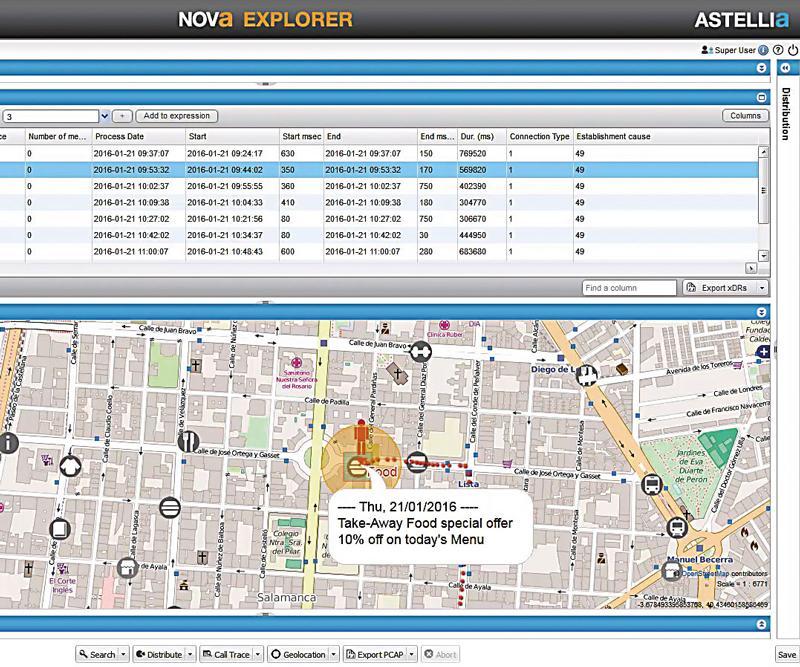With geolocation, mobile operators can find, determine and provide the exact location of a mobile phone (user) on their network. Geolocation is used in a variety of applications like troubleshooting and analytics, and opens up a whole range of possibilities for data monetization. In an interview with Telecom Review, Vicent Soler, EVP CTO Spain - Advanced RAN Studies, Astellia, talked about the importance of geolocation and its benefits.
Can you provide some concrete use cases of how network engineers can benefit from geolocation?
With geolocation, operators can have massive coverage maps and thereby it becomes much easier to identify any area with coverage holes, congestion or dropped calls. This allows network engineers to become much more efficient because they can focus network deployment and troubleshooting activities on these specific areas. Subsequently, this will have a concrete and positive impact on the subscriber experience.
Another relevant benefit of geolocation information for network engineers is that it helps accelerate the introduction of new technologies. It can help them, for instance, to identify where there is a high concentration of VoLTE capable mobile phones in the network in order to reinforce 4G coverage in these areas to ensure an optimal VoLTE experience.
At the moment operators are looking for solutions to offload the traffic from the macro cells. In this case, having information about where subscribers are located is very useful to define the right position to deploy new small cells.
Can geolocation information reduce the need for drive tests?
Yes, definitely. This is clearly one of the main benefits that geolocation brings to operators. By actively using geolocation information operators can save a lot of money. From Astellia's experience, we have seen that operators can reduce up to 90 percent of their investments in drive tests. A drive test is very costly because it is a manual procedure - you have to send a team into the field to launch measurements at each location. Additionally, drive tests can only generate a dozen of tests and therefore do not reflect the whole customer experience. They do not provide historical data and data is not available instantaneously. Furthermore, drive tests are often inefficient at reproducing an issue reported by a subscriber since the tests are performed outdoors. However, 70 percent of voice calls and 80 percent of data sessions occur indoors. So, in contrast to geolocation, drive tests do not provide a complete view of the customer experience.
launch measurements at each location. Additionally, drive tests can only generate a dozen of tests and therefore do not reflect the whole customer experience. They do not provide historical data and data is not available instantaneously. Furthermore, drive tests are often inefficient at reproducing an issue reported by a subscriber since the tests are performed outdoors. However, 70 percent of voice calls and 80 percent of data sessions occur indoors. So, in contrast to geolocation, drive tests do not provide a complete view of the customer experience.
How can geolocation information enrich customer experience management (CEM)?
Geolocation information increases customer care efficiency. By positioning failed calls on a map and analyzing subscriber mobility during a call, customer care agents will better understand a complaining subscriber and can bring a solution more quickly, not only to the complaining customer but also to all the subscribers in that area.
Each element that provides additional information on the customer, provides a better knowledge of that customer and hence insights to improve their experience. Valuable subscriber mobility information can be used to geolocate high revenue generating areas (roamers, VoLTE subscribers, fleets, etc.), determine the customer experience of these hot spots and avoid potential loss of revenues due to a bad functioning network in these areas.
How does geolocation data contribute to new revenue generation?
With the current internet of things (IoT) revolution, asset tracking is becoming a revenue generating and value-added service offered by operators to their enterprise customers. So being able to provide massive geolocation of low-cost IoT devices without costly GPS functionality is a clear competitive differentiator.
Marketing can exploit geolocation data to create additional revenues by, for instance, engaging with a customer accessing a predefined area. Some examples of use cases are location-based advertising, analysis of population flows for road traffic information, helping shopping malls understand where their customers are coming from and the time they are spending at their premises, etc.
What makes Astellia's geolocation solution unique?
First of all, Astellia's solution offers the best-in-class geolocation accuracy. Its algorithm is based on trilateration, minimization of drive tests (MDT) and includes machine learning evolution. It goes much further than providing a visibility at cell level; it gives a precision as near as 100m and with an evolution to less than 50 m with our latest innovations. It allows operators to distinguish indoor and outdoor communications and characterize static vs subscribers in motion, all while preserving individual customer privacy.
Through its 3D geolocation feature, the solution can represent on a map distinct quality of service (QoS) and quality of experience (QoE) for each floor of a building. Astellia's massive geolocation solution provides geolocated QoE of popular apps such as video (YouTube) and social media (Facebook). This allows engineers to adapt capacity for high-trafficking value-generating areas.
Astellia's awarded solution gives a real-time, end-to-end vision (RAN to Core) of the network, 24x7, for 100 percent of the calls. It is the first solution on the market to geolocate IoT devices on LoRA networks. This future-proof solution is completely virtualized and big data ready, and is already adopted by several major operator groups such as Telefonica to better optimize their network and improve the customer experience.











